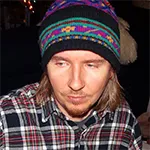Sava Šumanović – A Tragic Painter In A White Suit
by David Fox
Life is only one sad nothing. – S. Šumanović
Sava Šumanović’s life was brilliant, joyless, inspiring, sad, noble, tragic – all at once.

This artist was born in 1896 in Vinkovci (then in Austro-Hungary) as an only child in a respectable and wealthy family. When he was four years old, the family moved to Šid, a small town in West Serbia.
Sava’s father wanted for his only son to be a lawyer, but young Sava had different wishes. He had been fascinated by art since his school days. So, he resisted his father’s wish and went to Art Academy in Zagreb, instead of Law School.

He organized his first exhibition in 1918, at the very end of the studies. He earned great reviews and his popularity and influence had been gradually increasing since that moment. Symbolism and secession made a great impact on these paintings.
In 1920, he went to Paris, which is one of the most important points in his career. He spent six months there, painting and studying from French painter and teacher Andre Lhote, a cubist.

Rising Star
Lothe made a great impression on Sava, a young rising painter, who started to express himself through cubism and constructivism, just like his mentor.
Thanks to that, Šumanović became a pioneer of modernism in Serbian, Yugoslav painting. But introducing the Yugoslav audience to modernism wasn’t easy.
Namely, after returning from France, he organized an exhibition in Zagreb, but was deeply disappointed for criticisms being highly negative.

In his opinion, the problem for this outcome was the unadaptable Zagreb audience that wasn’t ready for anything new. He wasn’t an exception. He was rejected because he brought something new.
After coming back to Serbia, he started painting females and landscapes from around Šid. These motifs will dominate his paintings till the very end of his creation.
In 1925, he went to Paris one more time, but this time it wasn’t so bright and satisfying as it was when he first went there. He made some of his most famous paintings then – Drunken boat, inspired by famous Arthur Rimbaud’s poem with the same title, and Breakfast on Grass.

Struggle and Joy
Also, he participated in The Salon d’Automne (1926). Despite all that, he was coming across divided reviews, and those negative ones had a negative influence on his mental health.
His entire life in Paris in 1925 was a fierce struggle in himself, fighting against regret, against sentimentalism. Therefore, he painted pictures in a bright tone with a joyful coloration.
But it didn’t help – the real life was too damned, ugly and sad. Difficult working conditions, unsatisfying criticisms, a humiliating situation with a visa and a series of personal events made him psychically exhausted.
In order to get some rest, the painter returned to his homeland. In September 1928, he organized an exhibition in Belgrade which met excellent reception with the audience.
Later that year he went to Paris, again. It was his last stay in The City of Light. Paintings Red carpet, Lying female act, Luxembourg park in Paris… But his health condition soon got worse, and in 1930 he came back to Belgrade for treatment.

Two years after rest cure he returned to beloved Šid, this time for forever.
Knowledge and Experience
That decade (1932 – 1942 after he came home till his tragic death) was the most active period of his artistic creation. This period is considered the most important phase of his work and is called Šid’s phase.
Sava came back as a mature artist, full of knowledge and experience. He had ideal working conditions there. He was completely dedicated to painting. He had realized that he could fulfill his highest aim, which was to come up with his own style.
He didn’t want to be a Cubist, or Symbolist, or Impressionist, or anything else, but himself. And he succeeded it, he named his style as I can and ken.

This painter spent a lot of time in nature, enjoying Srem landscape and finding inspiration and motifs for his future paintings.
He was always going for a walk at the same time, wearing a white suit and carrying an umbrella. He was carrying his umbrella even in Summer, to protect the white suit from mulberry stains.
During this decade, Šumanović painted over 600 paintings. The most significant are two cycles – Šidijanke (which means women from Šid) and Grape harvesters.
The first cycle was completely presented at the exhibition in Belgrade in 1939. Grape harvesters is considered the beginning of a new cycle that was interrupted by the tragic death of the painter.

Murder
He was murdered during World War II. He had just finished Grape harvesters when pro-fascist collaborators came and took him in the dawn, 28 August 1942.
Two days later, 30 August, Sava Šumanović and 120 people from Šid, were unknowingly convicted, tortured and shot and then buried in mass grave in Sremska Mitrovica.
His mother succeeded to save his paintings during the war.
She also succeeded in creating a gallery in one of the family houses and gave the works of her son to Šid town. Gallery Sava Šumanović was founded in 1952 and Savas’s paintings still live there.

Here is a video that talks about Sava Šumanović. Unfortunately, it is not in English.

About David Fox
David Fox is an artist who created davidcharlesfox.com to talk about art and creativity. He loves to write, paint, and take pictures. David is also a big fan of spending time with his family and friends.
Leave a Reply
 |
 |
 |
 |
Now get FREE Gifts. Or latest Free phones here.
Disable Ad block to reveal all the secrets. Once done, hit a button below
 |
 |
 |
 |